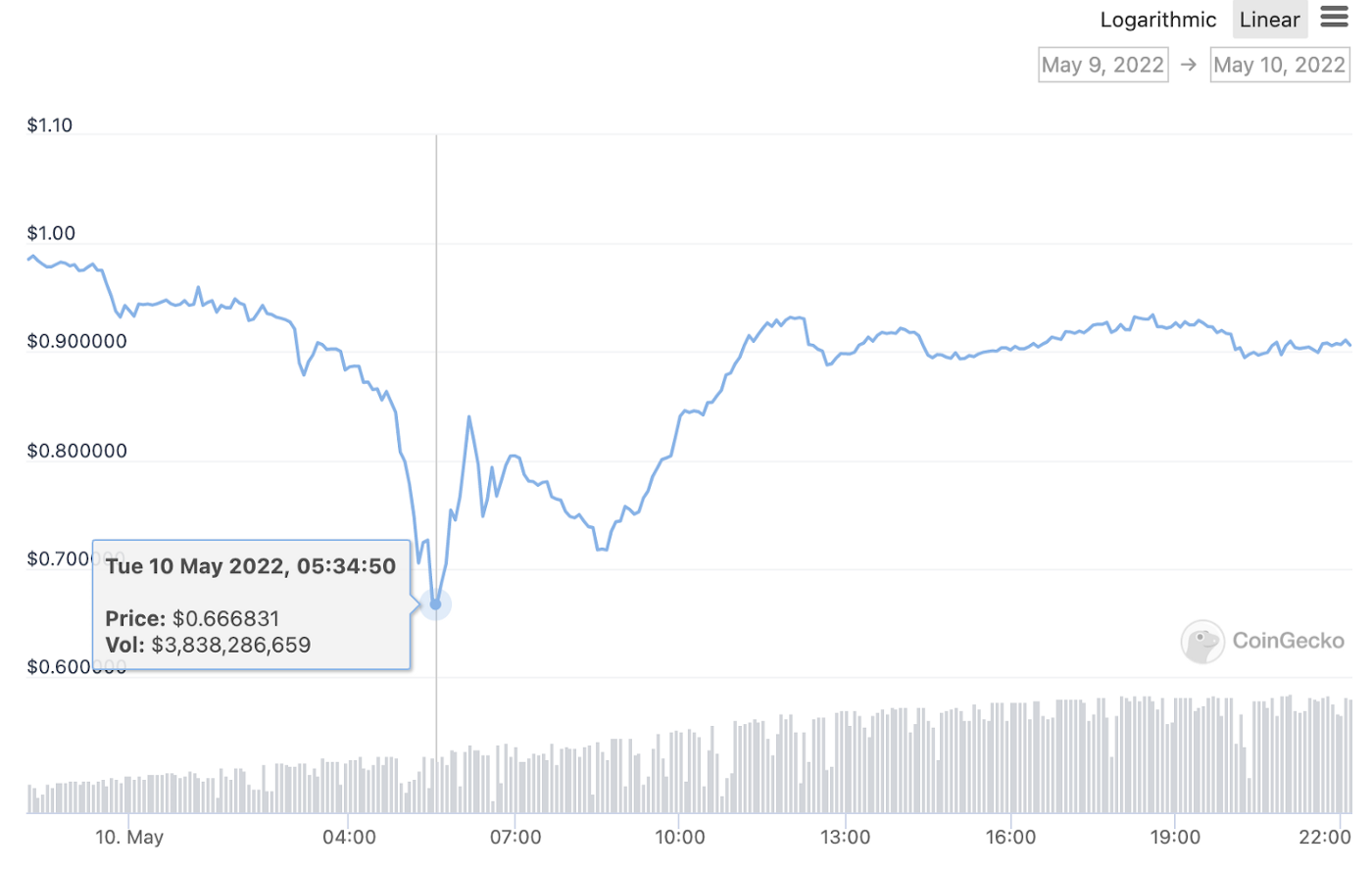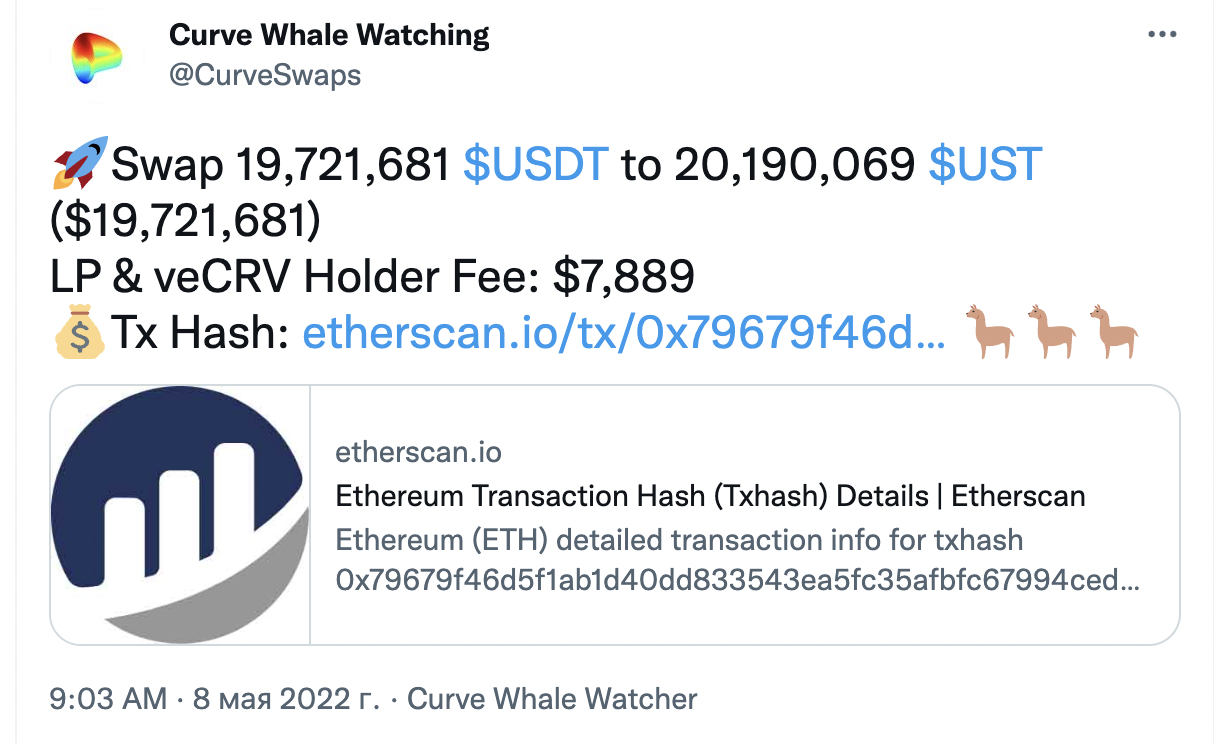Note: the material was prepared on May 10, some changes in the market movement are possible. All information was collected from open sources and DYOR
Death of UST
The stablecoin that’s 40% (at the time of writing) off track is instigating a lack of trust in all algorithmic stables. UST and LUNA may well become “Black Swans” for crypto and algorithmic stables.
In the past week, the Luna project and its decentralized stablecoin UST have experienced significant turmoil.
In early May, the UST token collapsed, reaching a price of $0.66.
https://www.coingecko.com/en/coins/terra-usd

What is UST backed by?
To begin with, let's see how popular tokens are secured compared to UST. DAI - is considered to be an oversecured coin (with more than 150-180% of its supply in assets), USDC is for the most part secured, and USDT - is claimed to be partially secured (there are many questions about how exactly it's secured - bonds, securities, or else). While all these three types are considered to be quite effective, UST has no such thing at all.
There is no such provision for UST but there is a regulatory mechanism of replicating UST through LUNA collateral and burning UST instead of LUNA. The founder decided to buy BTC and set a goal to create BTC reserves in the amount of $10b, for which he also received partial funding.
While BTC is starting to approach unpleasant levels of around $33k-$35k, there is news from the market that two companies - 3AC and Genesis - have loaded $0.5b and $1.5b in BTC, respectively, into the LUNA project.
General market tension, plus the fact that Luna's BTC collateral has begun to rapidly melt, has led to an outflow that began on May 4th 2022.
From deposits of $14b, $2.2b fled in 2 days. UST is pegged by 1% and costs about $0.992-$0.994 per 1 UST.
During the last unpeg in January, the Chicago firm Jump Crypto used its own funds to buy UST stablecoins on the market, bringing its value back to $1.
After the unpeg on May 4-5th 2022, Jump Crypto withdrew 74,400 ETH from Lido and used these funds to buy back UST and bring the balance back to normal.
https://etherscan.io/address/0x6b671b51258db0316dd89bc0075d6113488be5e8#internaltx
20,000 ETH was sent to Binance, where it was spent to take pressure off UST and support the $1 peg. At a price of $2,519, a sum of $187m was spent to stabilize the UST rate for a day, somewhat improving the situation.
Also, the peg recovery mechanism through the sale of UST for LUNA led to tremendous pressure on the price of the token. The LUNA token has fallen since the start of the outflow of deposits - from $86 to $31 (reaching a minimum $23.5 or a loss of -65%).
People are panicking
People are no longer sure about their UST and have started panic selling them. Here are some examples of how the tokens are being disposed of:
a.Some people are trying to dump their stocks but are only able to dump up to 1 million at a time without breaking the price too much.
b.The alternative asset management company Oapital is offloading the stable by transferring it to USDS, making $1 million with short breaks. There is no way to dispose of the whole amount without collapsing the market.
https://etherscan.io/address/0x66b870ddf78c975af5cd8edc6de25eca81791de1#tokentxns
Meanwhile, the Luna Foundation has pledged its 40k BTC to buy UST from the market to help balance the pool.
https://twitter.com/stablekwon/status/1523532474860539905
According to Luna's solution, the goal is to have this capital in the hands of a professional market maker in order to buy UST if the price is less than the peg and buy BTC if the price is higher or equal to the peg, thus significantly boosting liquidity around the UST peg.
The price of UST bounced to $0.91 because BTC bounced from $29,730 to $31,750 in one morning.
Opinions
Many see this as a deliberate action and are looking for those responsible. There are two main opinions about the situation.
Opinion 1
The attack on Terra-Luna-UST was deliberate and coordinated. A bulk dump of 285m UST on Curve and Binance by one player, followed by a massive short on Luna and the appearance of hundreds of Tweets... pure staging. Someone is sabotaging the project.
There are more and more rumors circulating that the BlackRock and Citadel funds exchanged 25,000 bitcoins for UST and offered Do Kwon from the Terra Foundation a deal to sell BTC for UST. As a result, the liquidity of UST significantly decreased, and then a deliberate drain of the asset began.
Opinion 2
Someone inside Genesis Trading is responsible for the attack. https://twitter.com/napgener/status/1523770359828578304
This reminds us of the argument between GiganticRebirth and Luna.
GCR shorted LUNA for $10 million after betting Do Kwon, the CEO of Terraform Labs and creator of LUNA, that LUNA would trade below $88 by March 2023.
Gigantic Rebirth, a pseudonymous crypto trader also known as GCR, made a $10 million bet on the future price of LUNA and doubled down on their bearish bet by shorting the coin for another $10 million.

GCR publicized the deal on their Twitter page, showing a short position in LUNA for the amount of $10.3 million at an opening price of about $90. https://twitter.com/GiganticRebirth/status/1522903921492168705?s=20&t=o7Xi9f31sVF1rfZVNCNHMQ
Final thoughts on Luna
GiganticRebirth (the whale who shorted LUNA from 90 bucks to 20 million) closed a $30 short.
Many who have already worked with pegged algorithmic stablecoins saw that the price was returning to $1, so there are large amounts of capital that have gone into XX so as to earn relatively risk-free.
Example: https://twitter.com/CurveSwaps/status/1523151625736450049

https://etherscan.io/tx/0x79679f46d5f1ab1d40dd833543ea5fc35afbfc67994cededa51c624f9117568a
If UST returns to a 1:1 peg with the U.S. dollar (which is likely to happen), the profit per transaction would be $468,000.
Even if the peg comes back, it is still a big blow to the trust and I do not expect any quick rebounds for LUNA in the coming months.
There are several suspected culprits that could be behind the manipulation, if indeed it was, but this is not what is most important. The mechanism must be resistant to attacks.
This is not the first case involving algorithmic stablecoins and I doubt it is the last. So you need to be careful, even when dealing with stablecoins, especially since there are so many in the market now on various different blockchains. If possible, diversify your stake in stables.
Our project has its own synthetic SSI token that consists of popular stablecoins, mitigating against any unforeseen fluctuations and other risks.
https://docs.spaceswap.app/spaceswap/products/index-token-platform
At one time, this development did not receive much attention from the market due to the “stability” of stablecoins, however, more and more questions are arising concerning other current projects.
What do you think of this situation? Feel free to share your thoughts in the comments and if you liked this review, be sure to repost it.
And while the market is experiencing fluctuations, we remain calm and watch how the events will go on.
Glossary
UST - an algorithmic stablecoin mainly backed by its sister cryptocurrency, LUNA, was also backed by bitcoin.
DAI - a stablecoin cryptocurrency on the Ethereum blockchain which aims to keep its value as close to one USD as possible through a system of smart contracts and the decentralized participants.
USDC - a digital currency that is fully backed by U.S. dollar assets. USDC is a tokenized U.S. dollar, with the value of one USDC coin pegged 1:1 to the value of one U.S. dollar.
USDT - a blockchain-based cryptocurrency whose tokens in circulation are backed by an equivalent amount of U.S. dollars, making it a stablecoin with a price pegged to USD $1.00.
Peg - a specified price for the rate of exchange between two assets. In crypto, a peg refers to the specific price that a token is aiming to stay at. The majority-case use of a peg is for stablecoins; digital tokens pegged to the value of traditional assets, such as the U.S. dollar.
Short (Shorting) - a trading method that involves selling an asset – like Bitcoin– with the hope of rebuying it later at a lower price. Traders enter a short position with the anticipation that the asset will decrease in value.
Algorithmic stablecoins - are tokens pegged to a fiat currency which is usually the US dollar. They respond to market events using predetermined stabilization measures hardcoded into smart contracts on Ethereum.
A black swan - an unpredictable event that is beyond what is normally expected of a situation and has potentially severe consequences.
